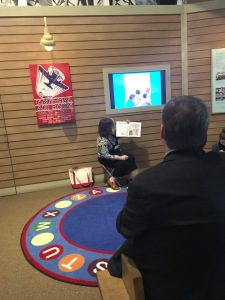“Museums are not just storage places.”
-Susan Wertheim of the National Gallery of Art
Museums can be many things but their first priority is to the visitor. Families, millennials, children, adults, each museum has a visitor base that they want to appeal the most to.
This was shown to us by Ann Caspari, Early Childhood Education Specialist at the National Air and Space Museum. Since it is mostly families that visit the museum, Ann and her team have developed story time programs that specially focus on the Pre-K through 2nd graders that try to bring the “people story” behind the objects to light. From my personal experience designing programming, this is probably the hardest age group to design well-rounded, educational and interactive programming for because most history deals with hard topics that can be uncomfortable to discuss with children under a certain age, or that feel too large to be brought to the learning level of one so young.
 The story that Ann shared with us, that they use in their “Flights of Fancy Storytime” programs, talked about Bessie Coleman, an African American woman who had to overcome many challenges to reach her dream of flying. Overcoming obstacles and learning to dream are two big storylines that I have noticed in books about famous Americans for this young age group and this story presented it in a way that was accessible and fun for children without getting too deep into ideas like racism and sexism, that were clearly present. I found it interesting that Ann said that she did a little editing of the story, to cut out a part of the book where Bessie’s death was discussed, but that in the long run the editing wasn’t out of disrespect to the author but rather respect to the visitor– most parents don’t expect an outing at an Air and Space museum to turn into a conversation about death, and Ann recognized that that one page in the book would overwhelm any other lesson that she was trying to get across.
The story that Ann shared with us, that they use in their “Flights of Fancy Storytime” programs, talked about Bessie Coleman, an African American woman who had to overcome many challenges to reach her dream of flying. Overcoming obstacles and learning to dream are two big storylines that I have noticed in books about famous Americans for this young age group and this story presented it in a way that was accessible and fun for children without getting too deep into ideas like racism and sexism, that were clearly present. I found it interesting that Ann said that she did a little editing of the story, to cut out a part of the book where Bessie’s death was discussed, but that in the long run the editing wasn’t out of disrespect to the author but rather respect to the visitor– most parents don’t expect an outing at an Air and Space museum to turn into a conversation about death, and Ann recognized that that one page in the book would overwhelm any other lesson that she was trying to get across.
Ann had some great pointers that I will certainly be incorporating into my own program design: use props, use movement, create a way to think about the people in the story as characters that develop, use object based learning to point out actual artifacts that accent the story, and to follow the story with something more hands-on such as a craft or free play. Making sure that kids in Pre-K through 2nd grade can associate themselves with people in the past is a critical part to helping them understand that history is bigger then just “a long time ago” and that they can interact with it in a tangible way can lead to both in the moment, and long-term, learning and interest.
